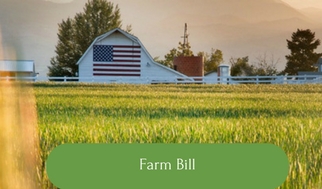BACKGROUND
The Farm Bill is an omnibus, multi-year law that governs an array of agricultural and food programs. The most recent Farm Bill, the Agricultural Act of 2018, expires at the beginning of 2023.
Key areas impacted by the Farm Bill include agriculture research, animal disease, conservation and climate resilience, cybersecurity, food safety, hemp, invasive species, local food systems, Specialty Crop Block Grants, and trade promotion.
Agriculture is a major driver of the New York State economy and just over a quarter of New York State’s land mass, or 7 million acres, is dedicated to farmland. Nearly 33,000 family farms produce some of the world’s best food, with the State ranking in the top 10 in 30 different commodities that support its communities. New York is the largest producer of cottage cheese, sour cream, and yogurt in the United States; The State ranks second in maple syrup, apples, and cabbage; third in grapes; and fourth in floriculture. It also ranks fifth in green peas, squash, and milk production, which is the largest segment of the state’s agricultural sector. Nearly 3,500 dairy farmers produce 15.5 billion pounds of milk annually in New York State.
From the beginning, but growing in importance in the past five decades, the farm bill has also been the controlling legislation for a variety of federal nutrition programs, most importantly the food stamp program, today known as the Supplemental Nutrition Assistance Program (SNAP).
About the Supplemental Nutrition Assistance Program (SNAP)
SNAP offers nutrition assistance to millions of eligible, low-income individuals and families and provides economic benefits to communities. SNAP is the largest program in the domestic hunger safety net. SNAP is the largest nutrition assistance program administered by the U.S. Department of Agriculture. SNAP was previously named the Food Stamp Program until Oct. 1, 2008. Every five years, SNAP is reauthorized by Congress as part of the Farm Bill. The reauthorization establishes who is eligible for SNAP and addresses program access, benefit levels, and other matters. In 2015 SNAP helped lift 4.6 million Americans out of poverty.
The Food and Nutrition Service works with State agencies, nutrition educators, and neighborhood and faith-based organizations to ensure that those eligible for nutrition assistance can make informed decisions about applying for the program and can access benefits. The U.S. Congress sets the food stamps benefit amount at, on average, roughly $4 a day per person and 83% of all SNAP/food stamp benefits go to households with a child, senior, or disabled person. Most food stamp recipients are children and the elderly.
Legislators at both the federal and state level – typically self-described conservatives – regularly try to place limits on the Supplemental Nutrition Assistance Program (SNAP, or “food stamps”). In recent years, they have tried to cut food stamp funding at every opportunity. They propose rules to humiliate and demonize recipients of food stamps and other welfare programs, which they claim create a “culture of dependency. BUT the truth about SNAP is:
- Each dollar spent in food stamp benefits generates nearly double that in local economic activity.
- To qualify, recipients’ households need to earn at or below 130% of the poverty line—or about $26,000 or less a year for a family of three
- More than half of SNAP households with at least one working-age, non-disabled adult work while on SNAP; more than 80% work in the year before or after receiving SNAP. For many of these families, SNAP is an important support while they are between jobs and looking for work.

